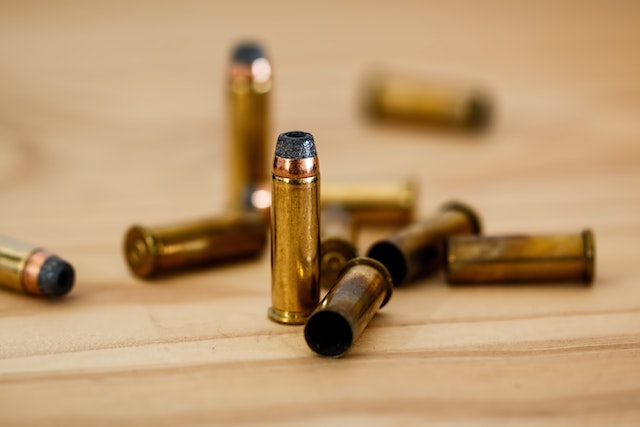
What is a hollow-point bullet? It is a bullet that expands on impact, causing more damage, without going all the way through the target.
With a hollow-point bullet, the tip is literally hollowed out. A cartridge has four parts. It has the case, which holds everything together. It has the primer, which is struck by the hammer and ignites the explosive. It has the explosive powder, which produces the pressure to expel the bullet from the gun. And it has the bullet, which is the part of the cartridge that leaves the gun barrel. The explosive powder is usually smokeless powder and the bullet is usually made of lead cased in copper, but they can be made of copper, steel, or rubber.
When guns were first invented, they didn’t have a lot of power and they used a ball of lead. The powder would be pushed down the barrel of the gun and the ball dropped down after it. When they were fired, they had enough power to injure someone over 500 meters away, but the ball didn’t travel in a straight line because the barrels of the guns didn’t have rifling yet. The balls were much larger than modern bullets and if they managed to hit someone at a close enough range, the soft lead would expand on impact and tear a hole through the person. They were fired at much lower velocities than modern bullets, but they did considerable damage.
The problem with an all lead bullet is that it is soft and deforms slightly in the barrel. It also melts at the high temperatures produced by powerful guns, lowering its velocity and range. To solve this problem, copper jacketed bullets were invented in 1882. Copper has a higher melting point and doesn’t deform under the pressure of the explosion, meaning more powerful guns could be used and velocity and range both improved. In the early 20th century, the spitzer bullet was invented. This was an aerodynamically pointed bullet, the kind that we use today. It was more accurate and had greater range.
Bullets that are more accurate and have greater range are wonderful if you are target shooting, sniping, or indiscriminately firing with a machine gun. The problem comes if you don’t want your bullet to go through whatever you are shooting at and the ten people behind them. This problem resulted in the invention of the hollow-point bullet. The tip of the hollow-point bullet is scooped out, leaving a divot. The bullets are made of lead, but are still copper jacketed to increase their range and accuracy. The copper is thinner at the front of the bullet. When the hollow-point hits its target, the divot fills with material, usually flesh, and the impact forces the bullet to expand sideways. Most hollow-points are designed to expand about 1.7 times.
There are two main reasons to use a hollow-point bullet. The first is that there is less risk to people behind the target. A regular bullet drills through the target and continues on, but the impact of the hollow-point removes a lot of its kinetic energy very quickly, which means that the bullet doesn’t travel very far through its target, usually not even exiting the target. The FBI requires its hollow-point bullets to have a penetration of between 30 and 45 cm. The second reason is that the impact force will cause a lot more internal damage, whereas a regular bullet will cut through cleanly, the hollow-point expands into a flat disk that smashes through, causing far more damage. There is more likelihood of stopping a target in its tracks with a hollow-point bullet. The American police use hollow-point bullets for these reasons.
However, there are three problems with hollow-point bullets. The first is that they are designed to flatten on impact, so a very thick coat might stop them. They would also be of less use against animals that have especially thick fur, like bears. They also don’t work in all guns and they are prone to jamming. And they are less accurate because of their shape. The jamming and accuracy problems are solved by adding a plastic point to the bullet. These plastic tips separate in flight.
The Hague Convention of 1899 banned hollow-point ammunition from warfare because of the unnecessary damage they cause. The expanded bullet causes more damage in the body and there is more likelihood of damage to major organs or blood vessels. The United States did not agree to that part of the Hague Convention and so their military are still allowed to use hollow-point ammunition.
So, hollow-point bullets have a divot scooped out of their point so that they expand on impact and don’t pass through the target. And this is what I learned today.
Sources
https://www.ballisticmag.com/bullet-physics-gunshot-wound-survival/
https://www.forbes5.pitt.edu/article/production-muskets-and-their-effects-eighteenth-century
https://en.wikipedia.org/wiki/Bullet
https://www.muddybay.com/blog/full-metal-jacketfmj-ammo-vs-hollow-point-rounds–31757
https://www.usconcealedcarry.com/blog/what-is-hollow-point-ammo/
https://en.wikipedia.org/wiki/Hollow-point_bullet
